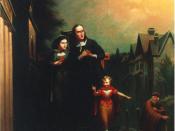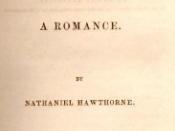Discuss how power is represented in relation to gender and religion in The Scarlet Letter.
The Scarlet Letter has been the subject to extensive examination and interpretation since it was published. Hawthorne's style, particularly in this novel, allows in-depth reading into his writing, with issues such as symbolism, and themes such as 'light and dark' or 'good and evil' all playing large parts in his work. Because of the large amount of interpretation that the novel can be subjected to it is important that evidence be provided to substantiate such arguments, and even then the evidence must be examined. This essay will discuss how power is represented in relation to gender and religion. In doing so its will attempt to use proof and suggestions from the novel and other sources to substantiate its statements and suggestions.
Hester Prynne, as a woman, holds very little power in The Scarlet Letter.
Through her relationships with Roger Chillingworth, Reverend Dimmesdale and the other inhabitants of the town Hester rarely finds herself in a position of control or power.
Roger Chillingworth, Hester's former partner, requests that she keep a secret of their past relationship when he first meets with her alone. He comments that he is "elsewhere a wanderer, isolated from human interests, I find here a woman, a man, a child amongst whom and myself the closest ligaments."#, suggesting this as one possible reason for his desire to remain in the town. Hester, it can be argued, now holds some form of power over Mr. Chillingworth. She can threaten to reveal his secret, and even do so if necessary. But she fails to either realise this, or accept it as a possibility. This is an example of Roger Chillingworth, the powerful male, dominating Hester, the female. The trend of power...


